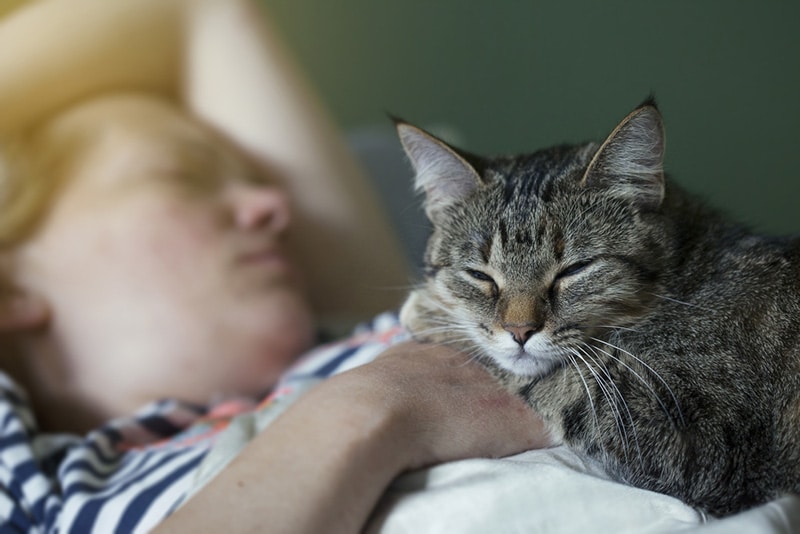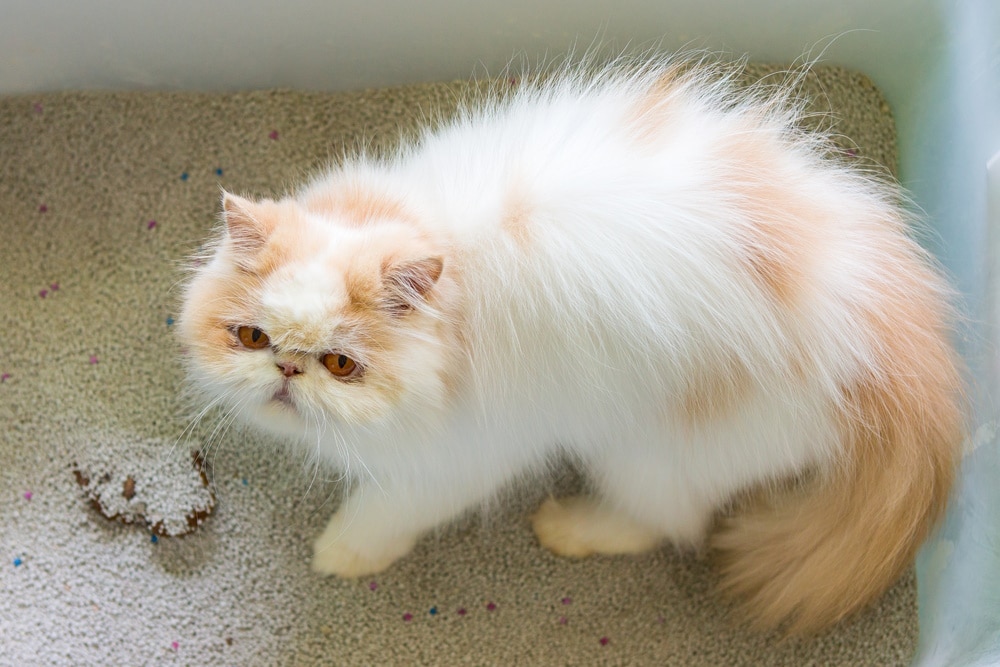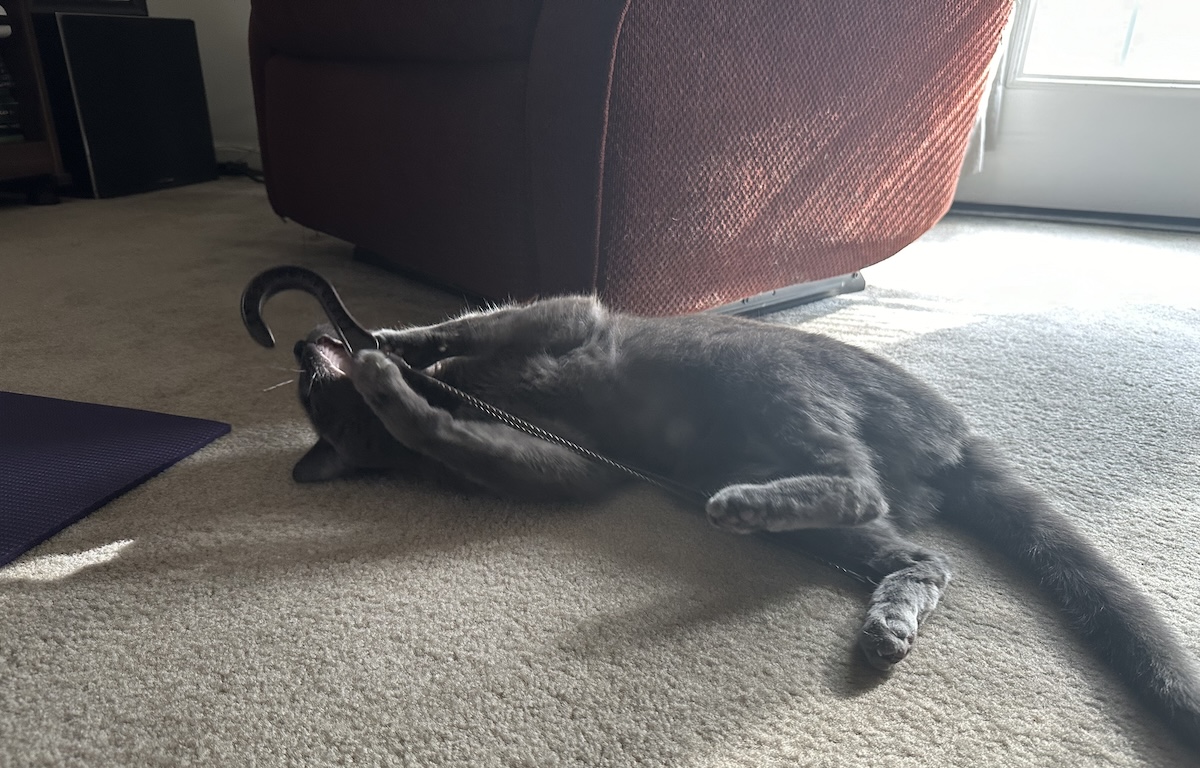When you’re sitting still or lying down for long enough, it’s perfectly normal for your cat to come around and try to spend a little extra time with you. But why is your cat taking every chance they get to sleep on your stomach?
There are a few different reasons your cat might always be seeking out your stomach, and the good news is that it’s almost always because they love you and want to spend as much time with you as possible!
But just because there’s usually nothing to worry about doesn’t mean you shouldn’t take the time to learn more about this behavior, so check out the five most common reasons your cat wants to lay on your stomach down below.
The 5 Reasons a Cat Lays on Your Stomach
1. To Stay Warm
| Likelihood | Moderate |
| Signs to Look For | Cold temperatures, shivering, or they feel cold |
If your cat sleeping on your stomach is a new thing and the winter months just started to hit, the change could be because they’re trying to keep warm. By lying on your stomach, your cat could be getting comfortable and taking in your extra body heat, which is a real win-win for them!
If your cat starts the behavior when things get cold and stops when things begin to warm up, is almost definitely the reason. Other telltale signs include a cold cat or a cat that’s shivering, but if this is the case, you need to make things a bit warmer for them. Turn that thermostat up!

2. You’re Comfortable
| Likelihood | Moderate |
| Signs to Look For | Purring and constantly seeking you out |
Have you ever enjoyed lying on a partner’s chest or stomach? If so, you know just how comforting it can be. Your cat will discover this too, and since they can curl up entirely on your stomach, it can be even more comfortable for them than you’d think.
If your cat is purring and constantly seeking you out to lay on, there’s a good chance it’s because your stomach is just a comfortable space to be.
3. You Make Them Feel Safe
| Likelihood | High |
| Signs to Look For | Purring, anxiety-inducing things are happening, they constantly seek you out |
Cats can take a while to warm up to people, but once they do, they can feel extremely safe around them. Chances are they’re only seeking you out because you make them feel safe, but if they’re only seeking out when something is stressing them out, you could be their go-to source for comfort.
Things like thunderstorms, construction work, fireworks, and other pets in the home are common causes of stress for them, and if they’re climbing on your stomach at these times, that could be why.

4. They’re Saying You Belong to Them
| Likelihood | High |
| Signs to Look For | Purring and rubbing themselves up against you |
Cats mark their territory through scent, and while they can do this through urine, they also do it by spreading pheromones. And what better way to mark their person as theirs than by sleeping on them?
Laying on your stomach is a prolonged activity that starts to get you smelling like them, and if they’re happy with you as their owner, they really want to let everyone know that you’re theirs!
5. They’re Saying They Love You
| Likelihood | High |
| Signs to Look For | Purring, constantly seeking your attention, wanting to play with you |
You might not think your cat shows a ton of affection towards you, but chances are that’s because you’re not quite sure how to recognize their affection. Cats typically love their owners and express their happiness with you in quite a few ways, including by wanting to be close to them.
If your cat is regularly climbing onto your stomach, purring, and trying to play with you throughout the day, they could be climbing onto your stomach simply because they love you.
An Important Note
In nearly all cases of your cat laying on your stomach, it simply means one of the above. However, if your cat is one that has never laid on you since the day you’ve had them, this change in behavior could be a cause for concern. Actually, any change in their normal behavior warrants a trip to the vet. You’d rather be safe than sorry!

Conclusion
If your cat is always trying to lay on your stomach and they’re not cold, it means you’re doing something right as a cat owner! They want to spend this extra time with you, and while it might not always be the most convenient or comfortable way for you, it’s a surefire sign that your cat loves you as much as you love them.
See also:
- Petting Aggression: Why Cats Bite the Hand They Love & What to Do
- What Should I Do If My Cat’s Food Is Recalled?
Featured Image Credit: OKcamera, Shutterstock









